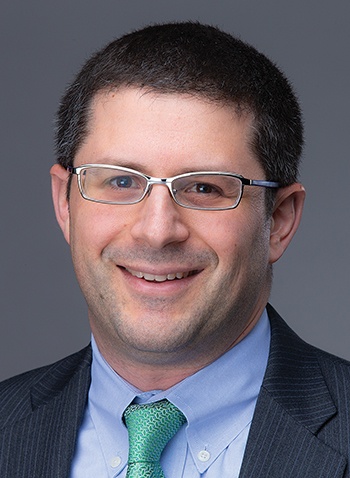
School BUSRide spoke with Adam Ruder, of the New York State Energy Research and Development Authority (NYSERDA). Ruder is the director for NYSERDA’s Clean Transportation group. The Clean Transportation group focuses on developing and demonstrating new technologies, policies, and business models that support three key focus areas: electric vehicles, public transportation, and mobility management.
Visit www.nyserda.ny.gov for
more information.

In terms of timelines and volume of school buses, what are the specific goals of the state in your efforts toward electrification of school buses?
New York is undertaking one of the most aggressive, if not the most aggressive school bus electrification programs in the country. Not only do we have more school buses than any other state, somewhere in the 40,000 to 45,000 range, but we have a requirement in law that all school buses purchased starting in July 2027 must be zero omission. All new school buses and all school buses operating in the state must be zero emission by 2035.
Is this part of a larger state government effort to advance clean air policies and practices?
New York has some broader goals, and this is a piece of that. This whole program is in support of the Climate Leadership and Community Protection Act’s goal to reduce greenhouse gas emissions by 85% by 2050, and to that end, there is a big focus in the transportation sector in general. The state is investing more than a billion dollars in electrifying the transportation sector that is for electric cars, trucks, buses, reducing emissions by getting more people onto transit and other low emission modes. We have rules in place that all new passenger cars sold will be zero emission by 2035, and we have broader goals for truck electrification as well.
What kind of funding is available to assist school districts and private contractors in attaining these goals on time?
That is a critical piece of this and we know that schools and contractors cannot do this alone. We currently have a New York Truck Voucher Incentive Program, NYTVIP, which provides rebates for fleets that buy electric buses and trucks. That is available today, and we have seen a number of schools take advantage, and school bus operators take advantage of that program already as well as other truck and bus operators in other segments of the medium and heavy duty market. We also provide technical assistance support where we will fund up to a hundred percent of the cost of developing a fleet transition plan for schools, which is a really critical step in making the right decisions and understanding the landscape behind electrifying a fleet. From a utility perspective, the utilities have a program to cover some of the utility side costs of charging upgrades and that is potentially expanding.
In November 2022 voters approved a $4.2 billion environmental bond act of which $500 million is dedicated for school bus electrification, and we expect that money to be available soon. Five hundred million will be for the buses and for charging associated with the buses, and we are really excited about being able to help schools with that. That is obviously all what New York State is doing. And then there are federal programs as well, obviously the EPA Clean School Bus program, the tax credits and the infrastructure tax credits.
How closely are your efforts coordinated with the federal EPA?
We talk to the EPA regularly and New York is really focused on trying to leverage what we are doing to bring more federal dollars to the state to help schools even more. We were very fortunate in New York to be the biggest recipient of the first round of clean school bus funds and more than 20 school districts and fleets received funding and more funding than any other state in the first round. We have been working with schools that are applying for this current round, the competitive round in New York state as well, and trying to help them make sure that they have the strongest application possible. And we’re generally trying to build our program and work with EPA to make sure that their program is coordinated with the programs are coordinated with each other, and that we set our program up in a way that helps people leverage that and use our program as cost share for EPA and really make their proposals to EPA more attractive.
Have you encountered any obstacles or challenges in terms of the supply chain for buses and charging stations that might affect the feasibility of the overall program?
Generally, we are well aware of the global supply chain issues that have been facing the industry specifically related to school buses. I have not seen as much of that being an issue. We have talked to school districts that have gotten electric buses on the timeline that they would normally get diesel buses or other buses, and we hear from the bus makers that they are all going to be ramping up their production quite dramatically over the next few years. Obviously, this is a huge expansion of rollout for New York State and for the country, and we need to see that continue. I am cautiously optimistic that the automakers are going to be able to respond to that demand and expand their capacity likewise.
How receptive have school bus operators, public and private, been to this initiative?
We have had great contact with districts and contractors. I want to give a shout-out to NYAPT, the New York Association of Pupil Transportation and the New York State School Bus Contractors Association who have both been great partners to date, making sure that their members are well-informed and get the best information available. We have talked to many of the 700 districts in the state through various types of outreach. We have had about a hundred districts either apply for or begin planning for their fleet transition through either our or their utilities, which all fleeted assessment services. Schools I think are eager to learn and they are eager to figure out how this can work. There are some schools that we have talked to that have been skeptical, but we have really focused on trying to help them understand how this can work for them and what the first steps are, and that even though these targets are aggressive, there are some real benefits here, and it does not mean that you need to transition your fleet next year.
This is still a longer-term phase in and something that we think is very achievable for all schools.
Many school districts, especially in NY, have budget processes that include public votes. Is there a risk that the taxpayers may say no to any of these bus initiatives and jeopardize the long-term goal? And how will that be handled with districts?
School budget votes are a local matter, and that is not something that we have a lot of expertise on here at NYSERDA. Our focus is really on trying to educate the school district decision makers and the public about the benefits of school bus electrification and to make sure that they are more likely to approve these types of expenses.
Is the state encouraging the introduction or expansion of other clean-fuel options or is the electric option the option of choice for the state?
Our focus is on zero emission, so electric or hydrogen fuel cell buses are really the two main options there. And quite frankly at this point, there are no hydrogen fuel cell school buses that are on the market or broadly available. Our focus today is really on electric.
Is there any targeting of urban areas over rural areas given the levels of congestion and pollution in those areas?
The Climate Act that I mentioned earlier, as well as the the Clean Water, Clean Air and Green Jobs Environmental Bond Act that approved $500 million requires that at least 35 percent of the benefits associated with our investments go to what communities identified as disadvantaged communities. We have a process for identifying those communities. It looks at a lot of different metrics. A lot of those communities are urban, but a number of them are rural as well. We clearly are focused on that, and I think that we will easily meet that level of investment in our disadvantaged communities. It is important also to note that there are opportunities for electrification in all different types of school districts. Almost every school district runs some shorter routes, some longer routes, and there are opportunities to try out electric buses on all different types of routes in virtually every school district. And there are some challenges that urban districts might have that rural districts do not have and vice versa.
We are really eager to try to work with all different types of school districts and work out some of those challenges. We are doing outreach to all of them with a focus on trying to get the money to the communities that need it most.
NAPT thanks Adam Ruder and NYSERDA for taking time to answer our questions. There are many states carrying out different initiatives in the electric school bus arena, and we are looking to bring more of their stories to our readers. In the case of New York, the ambitious goals and milestones were of great interest and concern as well as NYSERDA’s role in providing hands-on support and technical assistance. And, as Ruder pointed out, they also are working closely with New York Association for Pupil Transportation and the NYS School Bus Contractors Association, and those connections are important to NAPT moving forward. At NAPT, we see our role as providing our members unbiased information that can enable them to work locally to make choices and decisions that are good for their communities.
Governor Kathy Hochul recently announced the New York State Electric School Bus Roadmap and The Electric School Bus Guidebook to help New York P-12 schools transition bus fleets to zero-emission. These new resources provide school districts and bus operators with the technical and financial assistance necessary to remove fossil fuel vehicles from service and help reduce transportation emissions with a focus on disadvantaged communities and high-need school districts. Today’s announcement supports the Climate Leadership and Community Protection Act goal to reduce greenhouse gas emissions 85 percent by 2050 and New York State’s requirements that all new school buses sold in New York State be zero-emission by 2027 and all school buses on the road be zero-emission by 2035.
Both the roadmap and guidebook pinpoint critical factors and decisions that school districts and bus operators face when considering clean bus options. Zero-emission buses include both battery electric buses and hydrogen fuel cell buses which are expected to be available for purchase in New York State in the coming years. Both types of buses eliminate diesel and gasoline fumes that can drift into, and then linger within buses – negatively impacting air quality and child health.


